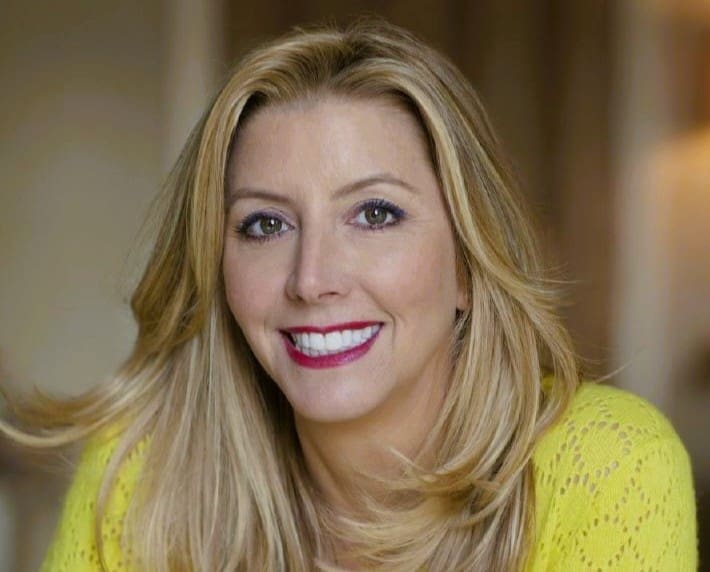Sara Blakely, then a door-to-door fax machine salesperson from Atlanta, Georgia, transformed a common wardrobe frustration into the billion-dollar global apparel empire known as Spanx. Armed with just $5,000 in savings and an idea born from cutting the feet off her pantyhose, Blakely launched her revolutionary shapewear in 2000. Through relentless persistence, savvy grassroots marketing, and an unwavering focus on solving a problem for women, she single-handedly built a new category in retail and, by 2012, was named by Forbes as the world’s youngest self-made female billionaire, cementing her legacy as a paragon of modern entrepreneurship.
The “Aha!” Moment and a Pair of Scissors
The origin of Spanx is a masterclass in identifying and solving a personal pain point. In the late 1990s, Blakely was getting ready for a party and wanted to wear a pair of cream-colored pants, but she lacked the right undergarment to create a smooth silhouette. Traditional shapewear was bulky and uncomfortable, while her pantyhose left an unsightly seam line at the toe.
In a moment of simple genius, she grabbed a pair of scissors and cut the feet off her control-top pantyhose. The top portion provided the smoothing effect she desired, but the makeshift garment continuously rolled up her legs throughout the night. It was this imperfection that sparked the pivotal thought: “This should exist for women.”
Blakely realized that a product that offered comfortable, seamless shaping without the feet simply wasn’t on the market. She saw a gap and, unlike many who have fleeting ideas, she decided to act on it.
From Cold Calls to a Patent
For the next two years, Blakely dedicated her nights and weekends to bringing her idea to life, all while maintaining her full-time job selling fax machines. Her sales experience proved invaluable, teaching her resilience and how to handle constant rejection. She spent countless hours at the Georgia Tech library, researching patents to ensure her idea was unique.
To save the $3,000 to $5,000 quoted by law firms, she bought a textbook and wrote her own patent application. This scrappy, do-it-yourself approach would become a hallmark of her early business strategy. Finding a manufacturer was her next great hurdle. She drove throughout North Carolina, cold-calling hosiery mills and facing a string of rejections from male executives who didn’t grasp the concept.
Finally, one mill owner in Asheboro, North Carolina, took a chance on her. After initially turning her down, he reconsidered after his two daughters enthusiastically validated the need for such a product. With a manufacturer secured, Blakely used her entire life savings of $5,000 to fund the initial production run.
The Neiman Marcus Breakthrough
With a product in hand, Blakely needed a retail partner. She set her sights high, targeting the prestigious department store Neiman Marcus. After securing a ten-minute meeting with a top buyer, she knew she had to make a lasting impression. When the buyer seemed unconvinced, Blakely took a bold risk.
She asked the buyer to accompany her to the women’s restroom. There, she did a live demonstration, changing from her regular underwear into a pair of Spanx to showcase the dramatic “before and after” effect under her own cream-colored pants. The visual proof was undeniable. The buyer was sold, and Spanx was placed in seven Neiman Marcus stores.
This single act of fearless, hands-on selling was the crucial first step in getting Spanx into the hands of consumers. Blakely even called friends and family across the country, asking them to go to their local Neiman Marcus and buy the product with enthusiasm to generate initial buzz and demand.
A “Favorite Thing” and an Empire’s Rise
The true turning point for Spanx came in 2000, not long after its launch. Understanding the power of media influencers, Blakely’s small team proactively sent a gift basket of products to the producers of The Oprah Winfrey Show. The gambit paid off spectacularly.
Oprah Winfrey, a cultural and commercial force, fell in love with the product and named Spanx one of her coveted “Favorite Things.” She publicly declared that Spanx had helped her look better in her clothes, providing the kind of authentic, powerful endorsement that money couldn’t buy.
The impact was immediate and explosive. The Spanx website, which Blakely had been running from her apartment, crashed under the surge of traffic. Retailers sold out of their inventory almost overnight. The Oprah endorsement catapulted Spanx from a niche startup into a national phenomenon and a household name.
Building a Brand on Authenticity
For nearly its first decade, Spanx famously spent zero dollars on traditional advertising. Blakely instead built her brand through clever public relations, word-of-mouth, and an authentic connection with her customer base. She understood that the product’s effectiveness was its best marketing tool.
A key element of her strategy was the packaging. In a sea of beige and clinical-looking hosiery packages, Blakely designed a bold, red box featuring a quirky, animated character named “Sunny.” This made Spanx instantly recognizable and approachable, standing out on crowded retail shelves.
Blakely herself was the face and voice of the brand. She traveled the country, doing in-store demonstrations at department stores and personally connecting with the women who were buying her products. This direct feedback loop allowed her to constantly innovate and expand the product line based on real customer needs.
The Spanx Culture: Celebrating Failure and Fun
Blakely’s leadership philosophy is as unconventional as her path to success. A core tenet of the Spanx corporate culture is the celebration of failure. This belief was instilled in her by her father, who would ask her and her brother at the dinner table, “What did you fail at this week?” If they had nothing to report, he would be disappointed, teaching them that a lack of failure meant a lack of trying.
She brought this mindset to Spanx headquarters, fostering an environment where employees are encouraged to take risks without fear of reprisal. The company has held “oops meetings” where employees share their mistakes and what they learned from them. This philosophy not only spurs innovation but also creates a deeply loyal and engaged workforce.
Billion-Dollar Milestones
The Forbes Cover
In March 2012, Sara Blakely’s entrepreneurial journey reached a monumental milestone. Forbes magazine featured her on its cover, declaring her the world’s youngest self-made female billionaire. At the time, her company was wholly owned by her, valued at $1 billion, and was generating an estimated 20% profit margin on nearly $250 million in annual revenue. This moment was more than a personal victory; it was a cultural touchstone that inspired countless aspiring entrepreneurs, particularly women.
The Blackstone Partnership
In 2021, Blakely sold a majority stake in Spanx to the private equity giant Blackstone in a deal that valued the company at an impressive $1.2 billion. True to her brand, the announcement was anything but typical. Blakely celebrated by gifting each of her employees $10,000 in cash and two first-class plane tickets to anywhere in the world.
Crucially, a key component of the deal was Blakely’s insistence on creating an all-female board of directors for Spanx, a rarity in the corporate world. This move solidified her commitment to female leadership and ensuring the brand’s governance reflected its customer base.
Beyond the Business: Philanthropy and Paying It Forward
With her immense success, Blakely has become a prominent philanthropist. She was one of the first female billionaires to sign The Giving Pledge, a campaign founded by Bill Gates and Warren Buffett that encourages the world’s wealthiest individuals to commit the majority of their wealth to charitable causes.
Through the Sara Blakely Foundation, she has donated millions to charities that focus on empowering women and girls through education and entrepreneurship. She is also a familiar face to aspiring business owners as a guest investor on the television show Shark Tank, where she frequently invests in and mentors female-founded companies.
Sara Blakely’s story is a powerful testament to the idea that a simple solution to a common problem can change the world. Her journey from selling fax machines to leading a billion-dollar brand offers an enduring lesson in the power of resilience, customer-centric innovation, and the profound impact of betting on yourself.








